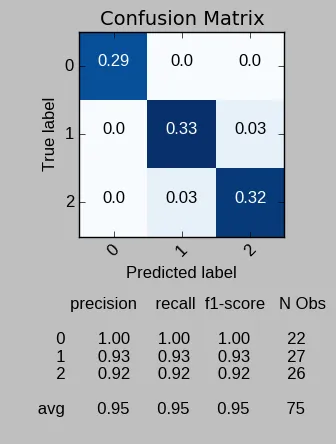这段代码:
打印:
我发现了一个类似的问题,链接如下:question。其中提到:
from pandas_ml import ConfusionMatrix
y_actu = [1,2]
y_pred = [1,2]
cm = ConfusionMatrix(y_actu, y_pred)
cm.print_stats()
打印:
population: 2
P: 1
N: 1
PositiveTest: 1
NegativeTest: 1
TP: 1
TN: 1
FP: 0
FN: 0
TPR: 1.0
TNR: 1.0
PPV: 1.0
NPV: 1.0
FPR: 0.0
FDR: 0.0
FNR: 0.0
ACC: 1.0
F1_score: 1.0
MCC: 1.0
informedness: 1.0
markedness: 1.0
prevalence: 0.5
LRP: inf
LRN: 0.0
DOR: inf
FOR: 0.0
/opt/conda/lib/python3.5/site-packages/pandas_ml/confusion_matrix/bcm.py:332: RuntimeWarning: divide by zero encountered in double_scalars
return(np.float64(self.TPR) / self.FPR)
这很正常。
然而,当我修改代码为以下内容时:
from pandas_ml import ConfusionMatrix
y_actu = [1,2,3]
y_pred = [1,2,3]
cm = ConfusionMatrix(y_actu, y_pred)
cm.print_stats()
使用:
y_actu = [1,2,3]
y_pred = [1,2,3]
这会导致出现以下错误:
OrderedDict([('Accuracy', 1.0), ('95% CI', (0.29240177382128668, nan)), ('No Information Rate', 'ToDo'), ('P-Value [Acc > NIR]', 0.29629629629629622), ('Kappa', 1.0), ("Mcnemar's Test P-Value", 'ToDo')])
ValueErrorTraceback (most recent call last)
<ipython-input-30-d8c5dc2bea73> in <module>()
3 y_pred = [1,2,3]
4 cm = ConfusionMatrix(y_actu, y_pred)
----> 5 cm.print_stats()
/opt/conda/lib/python3.5/site-packages/pandas_ml/confusion_matrix/abstract.py in print_stats(self, lst_stats)
446 Prints statistics
447 """
--> 448 print(self._str_stats(lst_stats))
449
450 def get(self, actual=None, predicted=None):
/opt/conda/lib/python3.5/site-packages/pandas_ml/confusion_matrix/abstract.py in _str_stats(self, lst_stats)
427 }
428
--> 429 stats = self.stats(lst_stats)
430
431 d_stats_str = collections.OrderedDict([
/opt/conda/lib/python3.5/site-packages/pandas_ml/confusion_matrix/abstract.py in stats(self, lst_stats)
390 d_stats = collections.OrderedDict()
391 d_stats['cm'] = self
--> 392 d_stats['overall'] = self.stats_overall
393 d_stats['class'] = self.stats_class
394 return(d_stats)
/opt/conda/lib/python3.5/site-packages/pandas_ml/confusion_matrix/cm.py in __getattr__(self, attr)
33 Returns (weighted) average statistics
34 """
---> 35 return(self._avg_stat(attr))
/opt/conda/lib/python3.5/site-packages/pandas_ml/confusion_matrix/abstract.py in _avg_stat(self, stat)
509 v = getattr(binary_cm, stat)
510 print(v)
--> 511 s_values[cls] = v
512 value = (s_values * self.true).sum() / self.population
513 return(value)
/opt/conda/lib/python3.5/site-packages/pandas/core/series.py in __setitem__(self, key, value)
771 # do the setitem
772 cacher_needs_updating = self._check_is_chained_assignment_possible()
--> 773 setitem(key, value)
774 if cacher_needs_updating:
775 self._maybe_update_cacher()
/opt/conda/lib/python3.5/site-packages/pandas/core/series.py in setitem(key, value)
767 pass
768
--> 769 self._set_with(key, value)
770
771 # do the setitem
/opt/conda/lib/python3.5/site-packages/pandas/core/series.py in _set_with(self, key, value)
809 if key_type == 'integer':
810 if self.index.inferred_type == 'integer':
--> 811 self._set_labels(key, value)
812 else:
813 return self._set_values(key, value)
/opt/conda/lib/python3.5/site-packages/pandas/core/series.py in _set_labels(self, key, value)
826 if mask.any():
827 raise ValueError('%s not contained in the index' % str(key[mask]))
--> 828 self._set_values(indexer, value)
829
830 def _set_values(self, key, value):
/opt/conda/lib/python3.5/site-packages/pandas/core/series.py in _set_values(self, key, value)
831 if isinstance(key, Series):
832 key = key._values
--> 833 self._data = self._data.setitem(indexer=key, value=value)
834 self._maybe_update_cacher()
835
/opt/conda/lib/python3.5/site-packages/pandas/core/internals.py in setitem(self, **kwargs)
3166
3167 def setitem(self, **kwargs):
-> 3168 return self.apply('setitem', **kwargs)
3169
3170 def putmask(self, **kwargs):
/opt/conda/lib/python3.5/site-packages/pandas/core/internals.py in apply(self, f, axes, filter, do_integrity_check, consolidate, **kwargs)
3054
3055 kwargs['mgr'] = self
-> 3056 applied = getattr(b, f)(**kwargs)
3057 result_blocks = _extend_blocks(applied, result_blocks)
3058
/opt/conda/lib/python3.5/site-packages/pandas/core/internals.py in setitem(self, indexer, value, mgr)
685 indexer.dtype == np.bool_ and
686 len(indexer[indexer]) == len(value)):
--> 687 raise ValueError("cannot set using a list-like indexer "
688 "with a different length than the value")
689
ValueError: cannot set using a list-like indexer with a different length than the value
我发现了一个类似的问题,链接如下:question。其中提到:
在赋值时使用本地列表是不被允许的,也不建议这样做。
什么是本地列表?我是否创建了一个?
